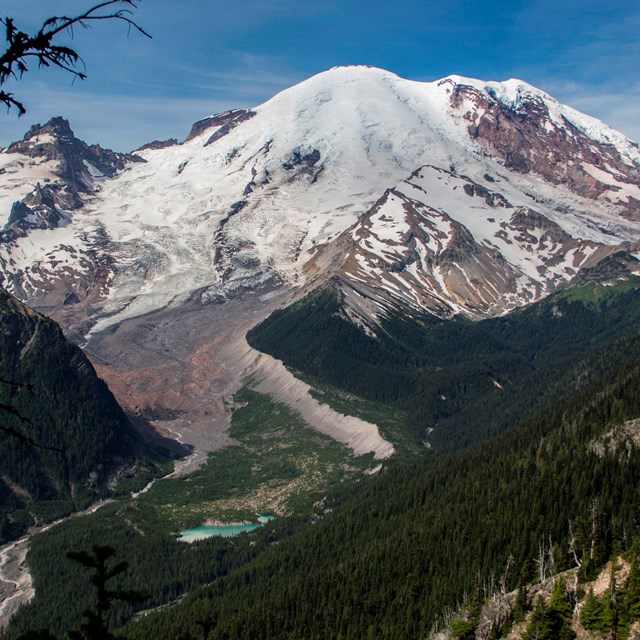
Mountain Building
► Plate Tectonics & Our National Parks
Tectonic processes shape the landscape and form some of the most spectacular structures found in national parks, from the highest peaks in Alaska to the faulted mountains and valleys in the Basin and Range Province. Understanding a park's plate tectonic history and setting can help you make sense of the landforms and scenery you see.
Learn More
► Mountain Ranges
Most mountain ranges are long and narrow because they form at plate boundaries or hotspots. The drop-down list below relates the major mountain ranges of the United States with their tectonic setting.
Alaska Range (Southcentral Alaska)—[Subduction Zone] and [Accreted Terranes]
Appalachian Mountain Belt (Eastern U.S.)—[Ancient Collisional Mountains]
Basin and Range (Southwest U.S.)—[Continental Rift]
Brooks Range (Northern Alaska)—[Collisional Mountains]
Cascade Range (Northwest U.S.)—[Subduction Zone] and [Accreted Terranes]
Coast Ranges (Southeast Alaska to Northern California)—[Subduction Zone] and [Accreted Terranes]
Hawaiian Island Chain (Pacific Plate)—[Oceanic Hotspot]
Marathon Mountains (Western Texas)—[Collisional Mountains]
Ouachita Mountains (Western Arkansas and Southeastern Oklahoma)—[Collisional Mountains]
Rocky Mountain System (Central U.S.)—Continental Craton Uplift and Fold/Thrust Belt [Site Under Development]
Sierra Nevada (California)—[Ancient Subduction Zone]
The Three Types of Convergent Boundaries
► Volcanic Mountains
Most earthquakes and volcanoes occur where the moving plates interact along their boundaries, in rift zones, and at hotspots. Volcanic eruptions have tremendous mountain building capacity. Volcanoes are prominent features of the Cascade Range mountains in the pacific northwest, and in Alaska's Aleutian Islands and the Alaska Peninsula. Mauna Kea volcano is the tallest mountain on Earth, although most of the volcano is underwater.
The Three Classic Types of Volcanoes
Learn More
Mountain Erosional Processes
► Glacial Erosion
Glaciers are moving masses of ice that can sculpt and carve landscapes by eroding the land beneath. As the ice moves down slope it may erode and transport vast quantities of rock and sediment. Glaciers carve distinctive, steep-walled and flat-bottomed valleys. U-shaped valleys, fjords, and hanging valleys are examples of the kinds of valleys glaciers can erode. The ridge lines of some mountain ranges display sharp arêtes and horns created by past glaciers.
► Weathering and Erosion
Weathering and erosion are geologic processes that shape Earth’s landforms over vast periods of time through the actions of water, wind, ice, and gravity.
► Fluvial Processes
Raindrops and flowing water shape the mountains by dislodging sediment from the slope and transporting material in streams and rivers. Young, tall mountains often have steep slopes and severe weather which can lead to high rates of erosion. In contrast, older, lower mountains may have gentler slopes and weather, and lower rates of erosion. In this way, the dynamic processes of mountain building, stream erosion, and climate interact with one another to create unique mountain landscapes.
Be Geohazard Aware
The mountain building and erosional processes that formed our spectacular national park scenery are still very much active today. Mountainous regions can be hazardous due to steep slopes and severe weather which lead to high rates of naturally occurring, dynamic geologic process. When you are planning your visit to a park or other natural site, take the time to learn about the geologic hazards that you may encounter.
Stories From Around the NPS
Earth scientists from many disciplines are working to improve the Park Service's ability to gather, analyze, and use geoscience information.
Related Links
Thank you for visiting Geology and Physical Processes of Mountains. Even more NPS Geology is available here:
Last updated: December 28, 2022






